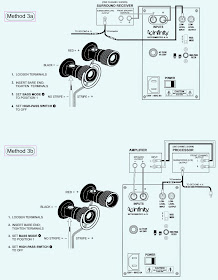CLICK ON THE PICTURES TO MAGNIFY
CONNECTIONS
For Methods 2, 3a, 3b and 4, make sure all bass management
features are properly set. The Audio channels should all be set to “Small” or
“High Pass” and the subwoofer set to “On.”
2-Channel receiver or integrated amplifier that has no
subwoofer output or Pre-Out/Main-In connectors [1]
2-Channel receiver or integrated amplifier with preamp
output and input connectors [2]
2-Channel system with separate preamplifier and power
amplifier [2].
Dolby Pro Logic®
with THX, Dolby Digital, or DTS ® receiver with a filtered subwoofer (or LFE)
output connector [3a]
Dolby® Digital or DTS processor with separate power
amplifiers or multi channel amplifier 3b Non-THX® -certified Dolby Pro Logic
receiver with full-range subwoofer outputs [4].
Final Positioning
After correctly connecting the Intermezzo 4.1t and verifying
that both the subwoofer and main section portions are playing, it is time to
optimize the system for your particular listening room. Earlier, you placed the loudspeakers in
their general location. Finding the exact location for optimum performance
sometimes only involves moving the speakers up to a few inches in any direction. We
urge you, therefore, to experiment with placement until your speakers deliver
their full potential. When the speakers are moved inward (toward each other)
there is generally better focus of instruments and vocalists; however, moving
the speakers too close together can reduce the spaciousness of the stage effect
and you may need to experiment with the trade-off between focus and imaging. If
your listening room is larger than average and your listening position is
relatively far from the speakers, wider placement of the speakers may be
required.
ADJUST BIAS PROCEDURE
(Mandatory when any output MOSFET transistors Q305, 310,
320, 321, 306, 307, 311, 312 are replaced)
1. Amplifier should be unplugged and OFF.
2. Remove Amp assembly from cabinet; remove rear plastic
guard, and detach entire assembly from black plastic cup containing the controls.
All wires exiting the assembly can remain connected unless they will prevent
you from removing the amplifier or accessing potentiometers on the Linear board
PCB in the following steps.
3. Identify the Linear board assembly (PCB with the output
transistors).
4. Adjust RP301 and RP302 fully counterclockwise. See
diagram below.
5. Apply 120 VAC power to unit; turn power switch ON.
6. Verify that LED lights on the front Gain Control dial,
unless you have disconnected the plug.
7. Connect voltmeter set to DC millivolt range to twin pins
on terminal J303, on Linear board.
8. Verify initial voltage is less then 0.1mV.
9. Adjust RP301 clockwise until voltmeter reads 0.3mV + the
initial current from step #8.
10. Adjust RP302 clockwise until voltmeter now reads 0.6mV +
the initial current from step #8.
11. Turn amplifier OFF. Disconnect AC power to unit.
12. Remove voltmeter from terminal J303.
13. Replace assembly to black plastic cup containing the
controls (be sure to reattach green ground wire to one screw); replace rear
plastic guard, any wires if disconnected, and replace amplifier back into
cabinet.
DISASSEMBLE PROCEDURE & EXPLODED VIEW






